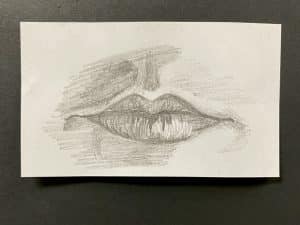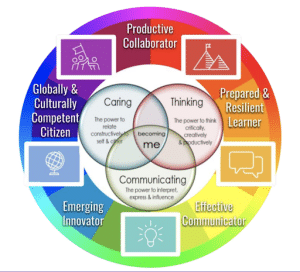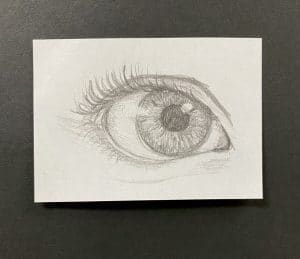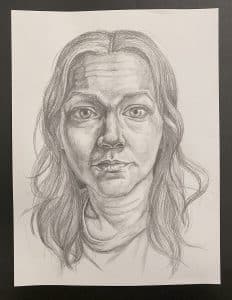A (Self) Portrait of a Graduate
CompetencyWorks Blog
“How do you grade art?” As a high school visual art teacher, this was the question I was always asked, and my response was usually: “Your guess is as good as mine.” All sarcasm aside, this is a major issue to contend with for any teacher in any subject area.
Traditionally, we have approached assessment as falling into two categories – formative and summative. Most of us have been taught and modeled a method in which the educator takes the predetermined learning product and breaks it down into more manageable and disparate steps so that once students complete them we can say, “‘Ta-da’! Now you just need to combine them all together to prove you learned something.” The problem with this method is that students have no part to play aside from receiving information and tasks, and then all too often, robotically puzzle-piecing those elements together.
By sticking to this industrialist method of education, it becomes hard to imagine that the learner themselves already brings knowledge and experience to the classroom and that they each have their own inspirations and aspirations. Most would agree that students who have more meaningful and authentic learning experiences will retain more knowledge and transferable skills. But how do we honor this concept without continuing to rely on the same metrics of assessment and success? Let’s use an example of a self-portrait assignment to illustrate the nature of this change.
Steps to a Self-Portrait
In my art classes, one of the goals was to have each student create a self-portrait. For this assignment, I asked students to carefully consider their own features while looking in a mirror. The goal was to make deliberate observations and not simply draw what they thought they looked like.
Before my assessment ‘awakening’, drawing an eye, like one to the right, was one of the ways I scaffolded and formatively assessed for creating the portrait. But now that I’ve taken a step back, is this really telling me that this artist (in this case, myself) knows how to draw a face? No.
Let’s see what happens if we expand this further by adding more parts to analyze…


When we break everything up into these siloed pieces and then combine them at the end we may get something close to what we were aiming for, but it’s still not exact. Close may result in what you see to the left. This is technically a self-portrait in the sense that it has all of the correct elements, and they are drawn and shaded accurately (if I do say so myself). However, none of the facial features reference each other, and therefore the work ends up looking like a sad attempt at postmodernism.
Finding the Full Picture
When we consider the bigger picture, if you will, and account for how the smaller parts relate to the whole, whether that be a portrait or a person, we will get a more complete sense of understanding. A singular eye, nose, or mouth, doesn’t offer any information about the way a person looks because we have to see the perspective and relationship of one feature to the next to make sense of the face. If we want learners to think critically, find their intrinsic motivation, and explore their passions, then we have to give them opportunities to attempt and practice deeper learning that doesn’t shy away from the complexities of the larger goal. We literally and figuratively need to offer students mirrors, so that they see themselves reflected in their work, and understand why that work is meaningful.
From Self-Portrait to Portrait of a Graduate
An even bigger picture to consider (a portfolio? a retrospective?) would be how we segment school into disciplines, courses, units, etc. I’ve never known a single adult who had a predetermined hour every day in which they only focused on math or science or anything else. The truth is that every person outside of the traditional, industrialist K-12 school system synthesizes information in interconnected ways.

As a district, Jefferson County Public Schools has begun to address this issue with our “Becoming Me” Graduate Profile. Throughout their tenure, students are asked to gather artifacts of their learning and consider how and why these have helped them grow in a set of global dispositions (effective communicator, productive collaborator, etc). At specified points in time, learners will present to a small panel about these reflections and discuss how their growth fits in with their larger goals. While it’s not a perfect system, it’s certainly a starting point to get our ~100,000 students to see the larger picture of their education.
As part of the JCPS Deeper Learning Team, we’re working to make more opportunities for authentic and meaningful educational experiences available to every learner – kids and adults alike. We offer support to teachers on topics related to project-based learning, competency-based education, personalized learning, and a lot more yet-to-be-trademarked methodologies. When our team creates professional development for school staff, we try to model what we hope to see in classrooms: collaborative protocols, co-creation of rubrics, and multiple opportunities for feedback and revision. Additionally, we like to start from an asset-based lens – what do our participants already know about this topic? What do they need more information about?
In my own classroom, after students completed a once-a-week, year-long passion project, I asked them to respond to a survey about their experience. Most of the form related to what they learned about, if they would choose the same project knowing what they know now, etc. One of the final questions related to whether they felt their passion project added to or detracted from their overall school experience that year. One student wrote something to the effect of, “If anything, the rest of my school experience detracted from my passion project. I wish I had way more time to work on this.” Imagine if this teenager had been given the opportunity to explore their topic or the necessary materials through the lens of other disciplines. Perhaps they would have more easily seen themselves reflected in their work.

Courtney Williams is a Deeper Learning Resource Teacher in Louisville, Kentucky. She is National Board Certified as a High School Visual Art Teacher. She hopes to spread the use of performance-based assessment, student passions, and creativity in all subject areas!

